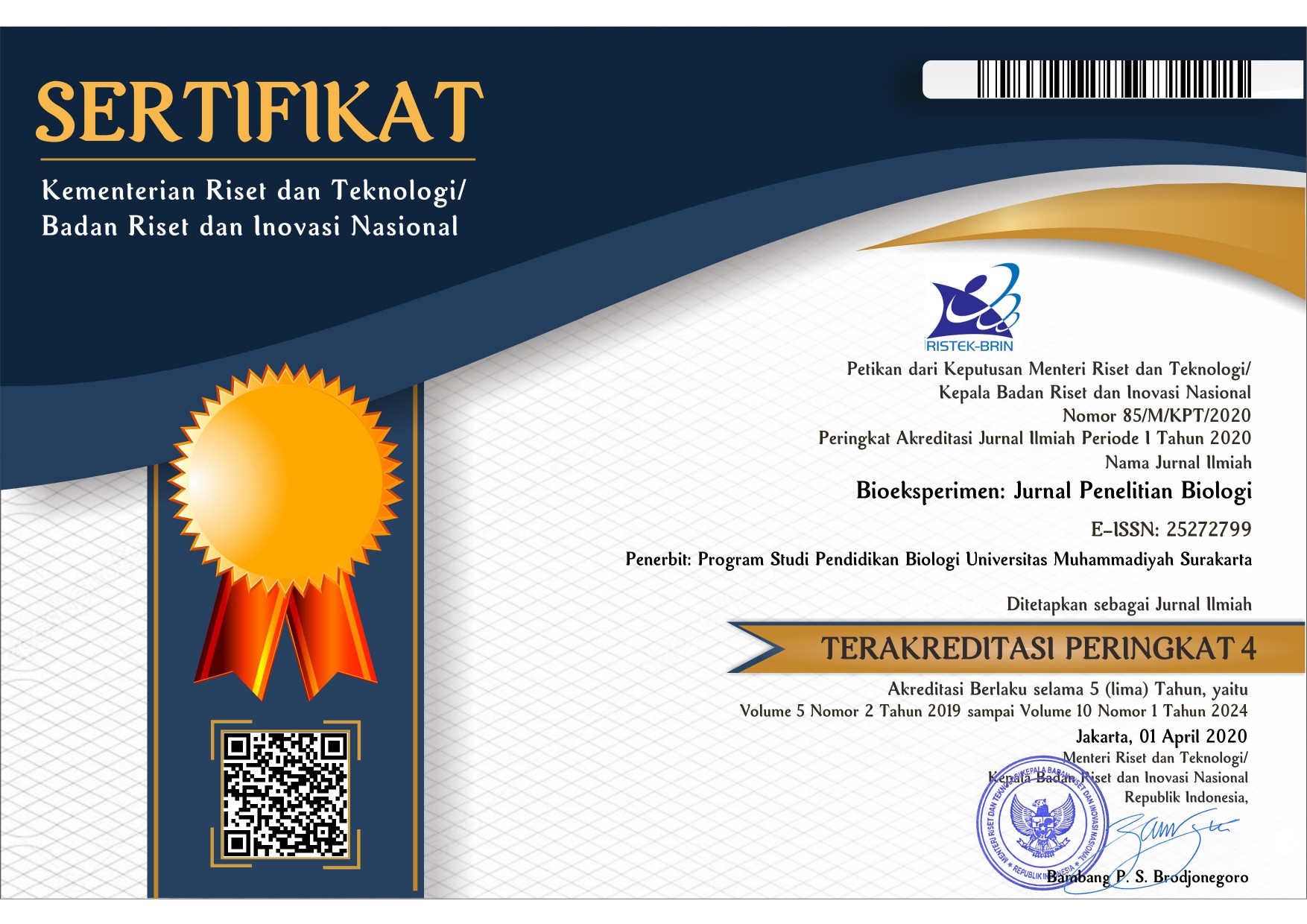Phycoremediation of Cadmium using Chlorella vulgaris in Photobioreactor
Anca Awal Sembada(1*), Teguh Adhitia Suyadi(2)(1) Bioengineering Study Program, School of Life Sciences and Technology, Institut Teknologi Bandung
(2) Bioengineering Study Program, School of Life Sciences and Technology, Institut Teknologi Bandung
(*) Corresponding Author
Abstract
Chlorella vulgaris had the ability to accumulate heavy metals in their bodies, so they could be used as biosorbent in handling heavy metal pollution in waters. The effectiveness of C. vulgaris in the remediation of cadmium (Cd) would be tested in this present study. C. vulgaris were cultured for 14 days in the photobioreactor which was an enclosed chamber that was fully aerated and illuminated with LED lamps. Cadmium with concentrations of 0 (control), 0.05, and 0.1 ppm was mixed with C. vulgaris growth medium. The number of C. vulgaris cells was counted every 3.5 days using a hemocytometer to determine the growth condition. Metal concentrations were also measured on days 0, 7, and 14 using atomic absorption spectrophotometry (AAS). C. vulgaris was able to reduce cadmium levels up to 98%. The decrease in cadmium levels with the highest efficiency occurred at a cadmium concentration of 0.05 ppm.
Keywords
Full Text:
PDF (Bahasa Indonesia)References
Abdi, O., & Kazemi, M. (2015). A review study of biosorption of heavy metals and comparison between different biosorbents. Journal of Materials and Environmental Science, 6(5), 1386-1399.
Arishi, A., & Mashhour, I. (2021). Microbial mechanisms for remediation of hexavalent chromium and their large-scale applications; Current research and future directions. Journal of Pure and Applied Microbiology, 15(1), 53-67.
Chen, M., Shafer-Peltier, K., Randtke, S. J., & Peltier, E. (2018). Competitive association of cations with poly (sodium 4-styrenesulfonate)(PSS) and heavy metal removal from water by PSS-assisted ultrafiltration. Chemical Engineering Journal, 344, 155-164.
Faizal, A., Sembada, A. A., & Priharto, N. (2021). Production of bioethanol from four species of duckweeds (Landoltia punctata, Lemna aequinoctialis, Spirodela polyrrhiza, and Wolffia arrhiza) through optimization of saccharification process and fermentation with Saccharomyces cerevisiae. Saudi journal of biological sciences, 28(1), 294-301.
Juneja, A., Ceballos, R. M., & Murthy, G. S. (2013). Effects of environmental factors and nutrient availability on the biochemical composition of algae for biofuels production: a review. Energies, 6(9), 4607-4638.
Kasa, N. A., Chormey, D. S., Büyükpınar, Ç., Turak, F., Budak, T. B., & Bakırdere, S. (2017). Determination of cadmium at ultratrace levels by dispersive liquid-liquid microextraction and batch type hydride generation atomic absorption spectrometry. Microchemical Journal, 133, 144-148.
Kumar, K. S., Dahms, H. U., Won, E. J., Lee, J. S., & Shin, K. H. (2015). Microalgae–a promising tool for heavy metal remediation. Ecotoxicology and environmental safety, 113, 329-352.
Lakaniemi, A. M., Intihar, V. M., Tuovinen, O. H., & Puhakka, J. A. (2012). Growth of Chlorella vulgaris and associated bacteria in photobioreactors. Microbial biotechnology, 5(1), 69-78.
Metsoviti, M. N., Papapolymerou, G., Karapanagiotidis, I. T., & Katsoulas, N. (2019). Effect of light intensity and quality on growth rate and composition of Chlorella vulgaris. Plants, 9(1), 31.
Panahi, Y., Khosroushahi, A. Y., Sahebkar, A., & Heidari, H. R. (2019). Impact of Cultivation Condition and Media Content on Chlorella vulgaris Composition. Advanced pharmaceutical bulletin, 9(2), 182.
Pandey, G., & Madhuri, S. (2014). Heavy metals causing toxicity in animals and fishes. Research Journal of Animal, Veterinary and Fishery Sciences, 2(2), 17-23.
Parrotta, L., Guerriero, G., Sergeant, K., Cai, G., & Hausman, J. F. (2015). Target or barrier? The cell wall of early-and later-diverging plants vs cadmium toxicity: differences in the response mechanisms. Frontiers in plant science, 6, 133.
Rahimzadeh, M. R., Rahimzadeh, M. R., Kazemi, S., & Moghadamnia, A. A. (2017). Cadmium toxicity and treatment: An update. Caspian journal of internal medicine, 8(3), 135.
Ras, M., Steyer, J. P., & Bernard, O. (2013). Temperature effect on microalgae: a crucial factor for outdoor production. Reviews in Environmental Science and Bio/Technology, 12(2), 153-164.
Ratomski, P., & Hawrot-Paw, M. (2021). Production of Chlorella vulgaris biomass in tubular photobioreactors during different culture conditions. Applied Sciences, 11(7), 3106.
Rizwan, M., Mujtaba, G., & Lee, K. (2017). Effects of iron sources on the growth and lipid/carbohydrate production of marine microalga Dunaliella tertiolecta. Biotechnology and Bioprocess Engineering, 22(1), 68-75.
Saber, I., Saeed, R. Z., Mehrdad, H., Hojjat, B., Amaneh, J., Ali, M. Z., & Hossein, B. A. (2011). Hg, Cd and Pb heavy metal bioremediation by Dunaliella alga. Journal of Medicinal Plants Research, 5(13), 2775-2780.
Sardar, K., Ali, S., Hameed, S., Afzal, S., Fatima, S., Shakoor, M. B., Bharwana, S. A., & Tauqeer, H. M. (2013). Heavy metals contamination and what are the impacts on living organisms. Greener Journal of Environmental management and public safety, 2(4), 172-179.
Sembada, A. A. (2022). Delignification of Cinnamon Bark (Cinnamomum verum) with Pre-treatment by NaOH to Increase Cellulose and Hemicellulose Recovery. Quagga: Jurnal Pendidikan Dan Biologi, 14(1), 73–76.
Sembada, A. A., & Faizal, A. (2022). Protein and Lipid Composition of Duckweeds (Landoltia punctata and Wolffia arrhiza) Grown in a Controlled Cultivation System. Asian Journal of Plant Sciences, 21(4), 637–642.
Sembada, A. A., & Suyadi, T. A. (2022). Ability of greater duckweed (Spirodela polyrrhiza) to absorb cadmium and its potency as phytoremediator. Edubiotik: Jurnal Pendidikan, Biologi dan Terapan, 7(02), 53-59.
Soares, E. V., & Soares, H. M. (2012). Bioremediation of industrial effluents containing heavy metals using brewing cells of Saccharomyces cerevisiae as a green technology: a review. Environmental Science and Pollution Research, 19(4), 1066-1083.
Ye, Y., Huang, Y., Xia, A., Fu, Q., Liao, Q., Zeng, W., Zheng, Y., & Zhu, X. (2018). Optimizing culture conditions for heterotrophic-assisted photoautotrophic biofilm growth of Chlorella vulgaris to simultaneously improve microalgae biomass and lipid productivity. Bioresource Technology, 270, 80-87.
Article Metrics
Abstract view(s): 757 time(s)PDF (Bahasa Indonesia): 439 time(s)
Refbacks
- There are currently no refbacks.








